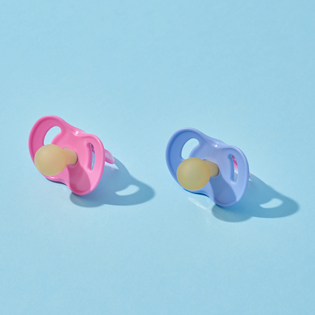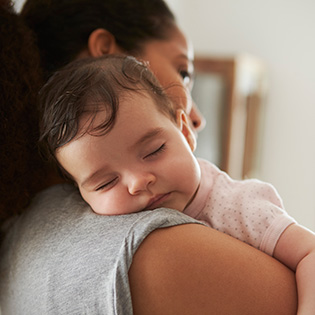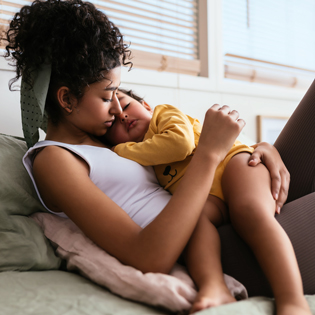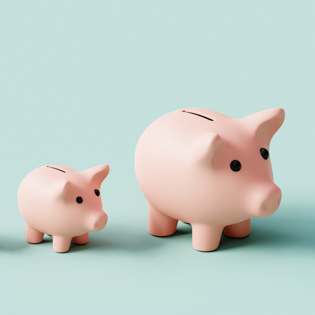No doubt about it, raising a child can be expensive. Just prepping for a baby’s arrival can set you back a few thousand dollars, between the car seat, stroller, crib and other big-ticket baby essentials.
Even if you opt for more affordable options, paying for all of the baby gear you need isn't cheap. So finding ways to save money on these pricier items is key. Even small discounts (percentage-wise) can add up to big savings when you're talking about high prices.
Use these tips from seasoned parents to save on big purchases without sacrificing quality, satisfaction or performance.
Just so you know, What to Expect may earn commissions from shopping links. Why trust our product recommendations?
1. Use your registry discount wisely
One of the best ways to save on baby gear is to use your baby registry completion discount. Amazon, Buy Buy Baby and Target all offer a 15 percent discount for you to use on any unpurchased items on your registry. For this reason, some parents register for everything needed for the first few years of their baby's life, whether they think anyone else will gift them the items or not.
Each retailer has some restrictions on their registry completion discount coupons, so you’ll want to read the fine print. For example, Amazon only offers 15 percent off to Prime members (10 percent for non-members), and can be used across multiple orders totaling up to $2,000. Buy Buy Baby’s discount cannot be combined with Bed Bath and Beyond’s famous coupons or applied to a number of brands excluded from discount offers, including Baby Jogger, BOB and Nanit.
But the savings can still be tremendous, especially for retailers that allow registry discounts on already-on-sale items (Amazon, Target and Buy Buy Baby all do), or allow you to stack coupons. At Target, for example, you can combine your 15 percent registry coupon with Target Circle offers, the 5 percent RedCard discount and team member discounts.
2. Sign up for store and brand newsletters
You know when you visit a retailer or a product manufacturer online and a pop-up window appears offering you discounts for providing your email address? Don't swat these offers away: If you like the store or brand, sign up to get coupons and sales information sent directly to you. Some brands will even reward you right away: brands like Itzy Ritzy and Ergobaby offer a 15 percent discount on an item or an order when you provide your contact information.
3. Join reward programs
Some retailers have frequent-shopper clubs that reward members in the form of additional discounts points to use towards purchases, and even exclusive sales. Amazon, for instance, restricts its Prime Day sale to Prime members. Although this membership costs $139 annually, Target's rewards program, Circle, and Buy Buy Baby's Welcome Rewards are free to join.
4. Time purchases during retailer and brand sale days
Baby gear vendors have sales all the time, but there are some specific sales events you might want to add to your calendar.
- Amazon Prime Day: Usually held in July, this sales event has been known to offer up to 70 percent off car seats, strollers and nursery gear. These deals, however, can come and go quickly, so be sure to act fast.
- Big Deal Baby Sale: Buy Buy Baby’s bi-annual sale occurs in the winter and in late summer. Brands are similar to Amazon's with parent favorites like Graco, Chicco and Fisher-Price, and bargains of 10 to 40 percent will last for several days.
- Target Deal Days: Offering steady bargains of 15 to 30 percent off, Target’s annual sales event is usually held on or around Prime Day in July. Along with brands also carried by Amazon and Buy Buy Baby, Target offers deep discounts on Target-exclusive brands like Cat & Jack, Cloud Island and Isabel Maternity by Ingrid & Isabel.
- Nordstrom Anniversary Sale: If luxury baby items are on your list, Nordstrom’s sale occurs each summer and features upscale brands like Uppababy and Baby Jogger.
Check out our month-by-month guide to the best yearly baby sales.
You can also look out for sales around the holidays, and follow the time-honored retailer sale schedule: Furniture sales late summer and winter, and tech sales around Labor Day.
Another option is to bookmark our Baby Deals page. This list is updated weekly with fresh sales on the items our readers love.
5. Use price-matching guarantees
Certain retailers, including Target, Walmart and Best Buy, promise to match competitors' prices — even if that means lowering their own prices. You will have to look into the specifics for each retailer, and do research to prove another retailer is selling an item for less. But in certain circumstances, a little bit of work on your end can lead to discounts.
6. Upcycle old gear at trade-in events
If you have a travel crib, car seat or stroller collecting dust, bring it to a trade-in event, in which retailers offer gift cards or store discounts for used gear. Target, for instance, has a twice-yearly Car Seat Trade-in event, which swaps a 20 percent off coupon for a used car seat, while Buy Buy Baby partners with gently-used gear retailer Good Buy to offer $50 to $500 gift cards for select used items.
Local stores may have their own events; ask around and look for flyers or other notices when you shop.
7. Consider buying used
Although some baby gear should never be bought second-hand (breast pumps, for instance, are a "single-user device" for sanitary reasons, and car seat material can degrade over time), there are plenty of items you can buy used, like high chairs, rockers/gliders and more. While getting second-hand items from friends and family is ideal (it’s free, after all) there are plenty of ways to find quality, used baby gear: Mercari and Facebook Marketplace are popular places for local moms to offload their old gear, while Good Buy Gear sells used baby essentials in partnership with Buy Buy Baby.
Another low-risk way to buy “used” is to buy the floor model of items at local baby stores; they're often available at deep discounts for the asking.
A note of caution: Always check the United States Consumer Product Safety Commission Recall Finder before buying an item to make sure it hasn't been recalled.
8. Consider a travel system
You can save by buying a travel system, which comes with an infant car seat and compatible stroller, rather than buying each component separately. Consider the Chicco Bravo Trio travel system. At $450, it's $50 cheaper than buying the KeyFit 30 infant car seat ($230) and Bravo stroller ($270) unbundled. Not every brand offers this kind of savings on travel systems, so do a little research to make sure your set is coming at a discount before using this tip.
9. Buy fewer car seats
Most people buy a rear-facing infant car seat to take their baby home from the hospital, then a convertible car seat that “converts” from rear- to front-facing as your baby grows and finally a booster seat to “boost” your child up to safely use your car's seat belt as a restraint rather than a five-point harness on the car seat itself.
But it's perfectly safe to skip the infant seat altogether and bring your baby home in a convertible, provided it's rated for your baby's size (and with many convertibles suitable for babies as little as four pounds, it likely is). You can also try an all-in-one seat, like the Graco 4Ever or the Britax One4Life, which can hold your child from their first car ride until they're ready to be out of car seats altogether. Either way, you'll save big and reduce your carbon footprint at the same time.
And while you're shopping, remember that a higher price tag doesn't mean a safer ride: All car seats sold in the United States must adhere to the same federal motor vehicle safety standards. Any car seat used properly will keep your child safer in the event of a collision, so don't worry buying a bargain seat means compromising your child's safety.
10. Look into a free or discounted car seat program
Mindful of the expense of car seats (and their importance for children's safety), many charities that work with low-income families have free car seat programs. Unfortunately, there's no cohesive national program for doing so; you'll find these resources concentrated at the state or local level.
If you receive support such as WIC or Medicaid, ask your case manager if they know of any such programs in your area. The website Safe Convertible Car Seats also lists free car seat programs in every state; you can use that list as a jumping off point to finding what's available in your area.
11. Think creatively about nursery furniture
Depending on your space and budget, nursery furniture that combines functions can be cheaper than buying a separate unit for each. Many play yards come with bassinet and changing table features, while some cribs may have built-in space for changing diapers and storing baby items. You can also turn a dresser you already own into a changing table by adding a small, inexpensive changing pad.
12. Buy items that grow with your baby
Many baby items are built to change uses as your child grows and develops. For example, activity centers that entertain pre-walking babies then transform into toddler tables, and high chairs that can be turned into toddler seats and, later, youth chairs.
A convertible crib is the classic example of this strategy. Unlike mini cribs and even full-size cribs, which are made to hold your baby safely for a limited amount of time, convertible cribs can turn into a toddler bed with a rail, then a daybed and, finally, a regular twin bed. You may have to spend a bit more upfront, but it’ll prevent you from buying multiple beds.
13. Start shopping early
The more time you have before your child's due date, the more time you can take to scout around for bargains. You can solicit hand-me-downs from loved ones and wait for gifts to roll in from your registry; you can locate favored brands and retailers, and patiently anticipate the sales that will bring your desired items into your price range.









































 Trending On What to Expect
Trending On What to Expect







